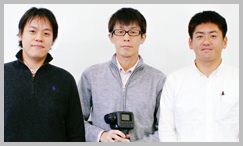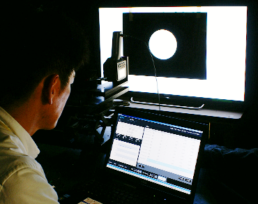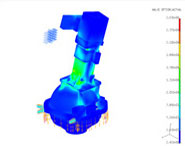LS-150 and CS-150A Luminance and Color Meters Developers Interview
Overview
A popular product since its launch in 1986, the LS-100 and CS-100A series have been put to use in a wide variety of industries thanks to their portability and ease of use. In December 2015, Konica Minolta updated the series with new models.
In developing the new products, numerous functions were added, and basic performance was improved for better compatibility with the latest trends in light sources, including OLEDs, laser projectors, and LCD TVs.
In this interview, we’ll meet three of the project development engineers and speak with them about the major points they focused on and the struggles they faced in bringing these new models to life.

Drastic Improvements in Basic Performance including Absolute-Value Precision
First, we spoke with R&D Division’s Shigeaki Tochimoto about how the attention to detail in the internal construction of the LS-150 and CS-150 led to their increased durability.
The LS-150 and CS-150 were developed to easily meet the needs of customers looking to measure LED brightness. Compared with previous models, how has the basic performance been improved in the new models?
Today’s LEDs are becoming increasingly brighter and offering higher saturation. To be better suited for the increased brightness, we expanded the measurable range of brightness by one digit. In addition, when using the older models to measure light sources with a narrow emission wavelength range, such as higher-intensity LEDs, errors tended to increase. The new sensors included in the LS-150 and CS-150 offers increased measurement accuracy which significantly reduced the instrumental errors.
So it’s safe to say that you’ve made drastic improvements to the basic performance. Was this a difficult task to accomplish?
A devices basic performance is determined by the design of its optical components, so we dedicated ourselves to redesigning the key parts. To minimize absolute-value errors and inter-instrument errors even when measuring various types of light sources from different manufacturers—including LEDs, OLEDs, projectors, and LCD displays—we performed multiple simulations using the spectral waveform data of each light source. This allowed us to optimize the design and thus significantly increase the basic performance level.
Besides simulations, did you also test the capabilities using the actual equipment?
Yes, we verified our findings through actual measurements. Some aspects can only be realized through real life measurement, so we provided our feedback and results to the design and manufacturing of the device whenever necessary.
Did you face any struggles in the verification process?
After evaluating the traditional verification methods prior to the initial improvement made to the performance and functions, there were some areas that needed to be reviewed. We often struggled to determine suitable measurement conditions, evaluation equipment, and other factors for verifying the improvements. In the end, however, we used the actual equipment to measure a wide variety of light sources and verified that the results were convincingly accurate.
Added Measurement Functions with a Focus on Usability
In addition to performance improvements, measurement functions have also been significantly revamped.
Light source measurements are often performed in dark locations. To make operations easy and to be able to see measurement results in the dark, we’ve added a backlight function that illuminates the LCD screen and operation keys by the press of the button. The backlight button is always illuminated to ensure it can be easily found, even in dark locations.
Another new feature is the automatic mode function. Using this function, the optimal measurement time will be selected automatically according to the brightness of the measurement object. This feature means stable measurement values can be obtained, which in turn improves work efficiency.
With the CS-150, we enhanced the colorimetric system in response to users who want to measure color temperature and dominant wavelength. To make this convenient, a simple click of the COLOR button will switch displays.
In addition to adding new functions, we’ve also improved operability. Our focus on operability led us to place the frequently used backlight and COLOR button for switching color mode in an easily accessible location on the left side, under the screen. The four-way controller, menu, and ESC button, which are used as a set, were placed on the right side.
Not only have you added many functions sought by customers, but you’ve also implemented various ideas as far as the overall design in your efforts to improve usability. On that note, could you please offer a few closing words?
With the LS-150 and CS-150, we’ve greatly improved absolute value precision and enriched functionality through easier operability. These models are the proud creation of a united employee development effort meant to ensure our customers are able to perform the measurements they want with confidence. We encourage everyone to give these instruments a try and experience their power first-hand.

